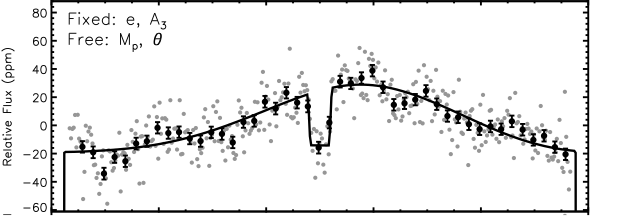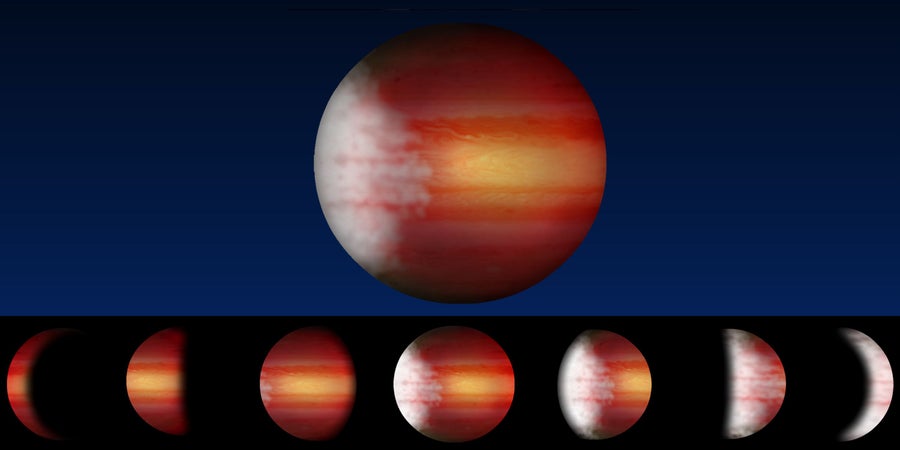This article was published in Scientific American’s former blog network and reflects the views of the author, not necessarily those of Scientific American
NASA’s Kepler mission has provided a treasure trove of stellar ‘Big Data’ that continues to yield marvelous results. Now a new study, to be published in TheAstrophysical Journal by Esteves et al., is providing some remarkable clues to the characteristics of planets on very short orbits around their stars.
Kepler’s primary mission has been to accumulate stellar lightcurves – extremely precise measurements of the light coming from stars as a function of time. A primary target in these lightcurves is the detection of planetary transits – the tiny dips in light caused when a planet passes between us and its stellar parent. Transits have yielded an astonishing haul of new worlds – with over 1,000 objects confirmed and more than 4,000 good candidates lurking in the archives.
But while transits are relatively short, sharp deviations in flux, Kepler’s sensitivity also allows researchers to investigate the slower phase variations in light that can come from a glowing or reflecting planet orbiting a star (or for that matter from rotating features on the star itself). These subtle changes in the total brightness of a system typically show up as sinusoidal variations closely related to the orbital motion of the planets.
On supporting science journalism
If you're enjoying this article, consider supporting our award-winning journalism by subscribing. By purchasing a subscription you are helping to ensure the future of impactful stories about the discoveries and ideas shaping our world today.
By sifting through about four and a half-years worth of Kepler data, Esteves et al. have identified 14 planetary systems where there are clear signs of these phase variations. Intriguingly, in six of these cases (some known from before), the varying light is not in perfect phase with what you’d expect from a straightforwardly reflective planet as it dips behind its star in secondary eclipse.
Here’s a nice little cartoon to illustrate phase variation in a simple in-phase system:

The phases and fluxes from a transiting planet system (Credit: Josh Winn, MIT).
The gentle decrease and increase of total system flux hits its minimum and peak right at the time the planet transits or is eclipsed by the star – in perfect phase.
By contrast, here’s an example of one of the six systems with a phase shift, or offset, centered around the secondary eclipse – when the planet moves behind the star. The curve is asymmetrical.

Lightcurve of Kepler-7b. (Credit: Esteves et al. 2015, The Astrophysical Journal)
So what could be causing the phase shift in all these systems?
The idea that Esteves et al. discuss suggests that what we’re seeing is a direct consequence of the atmospheric condition of these planets, with these new analyses supporting earlier results by other groups.
All of these worlds are hefty gas giants, about the size of Jupiter or a little larger. They all orbit their stars very closely – zooming around in just a few days at most – which makes it likely that they are in tidal lock, or spin-orbit synchronicity, where their day length equals their year length.
Existing observations of planets in similar conditions, combined with models of the atmospheric properties, suggest that the upper atmosphere is heated on the dayside (at the so-called sub-stellar point) but flows strongly with the planet’s rotation direction, towards the ‘evening’ and night side. This can offset the hottest point in the planetary atmosphere, shifting it towards the evening terminator.
But Kepler is mostly detecting reflected light, not so much the emitted glow of a hot planet - unless it’s really hot (over 2,300 Kelvin). And the four cooler planets in this new sample show signs of an increase in reflected light from their ‘morning’ terminator side, the side that’s facing us as the planets emerge from behind their stars.
What may be happening is that the same atmospheric flow that goes from day to night, and on to day again, is carrying clouds of particles that form on the cold nightside around to the ‘morning’. These condensates help reflect more light from the planet before being heated up and dissipated as they pass through the full dayside.

Illustration of the ‘morning’ clouds seen from our perspective at different points during the planet’s orbit (Credit: Lisa Esteves/University of Toronto).
It’s a complicated situation for our Earth-centric brains to deal with. Another way to think about this is from the point of view of someone exploring one of these planets.
Imagine they’re in a spacecraft and they decide to fly around this world. They start out on the cold night side. Below them a great cap of clouds has formed as gases cool off in the dark. Next, they fly in the direction of the planet’s spin and come up to the morning terminator – and they witness the scorching star rising above the horizon.
Looking down, the explorers see that the planet’s night clouds are also flowing into this morning, and reflecting brilliantly. But as the spacecraft moves further around and into the dayside, the temperature increases and the clouds begin to evaporate back into gas. In other words, an overcast morning gives way to the clear skies of midday and afternoon.
What are the clouds made of? We don’t know. But some candidates for these hot Jupiter worlds are the minerals perovskite (CaTiO3) and forsterite (Mg2SiO4).
As brutal as these planetary environments are compared to our comfort zone, there is nonetheless something remarkably captivating about learning these details. Exoplanetary science is truly moving into an era where individual worlds begin to write their books for us.